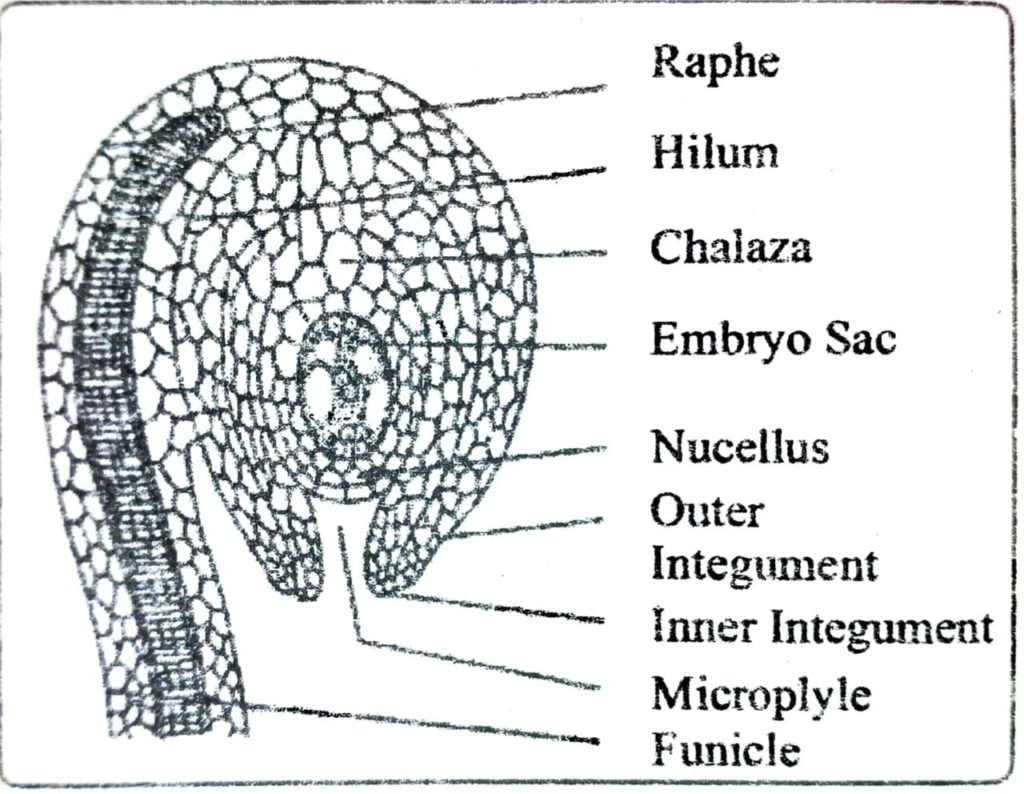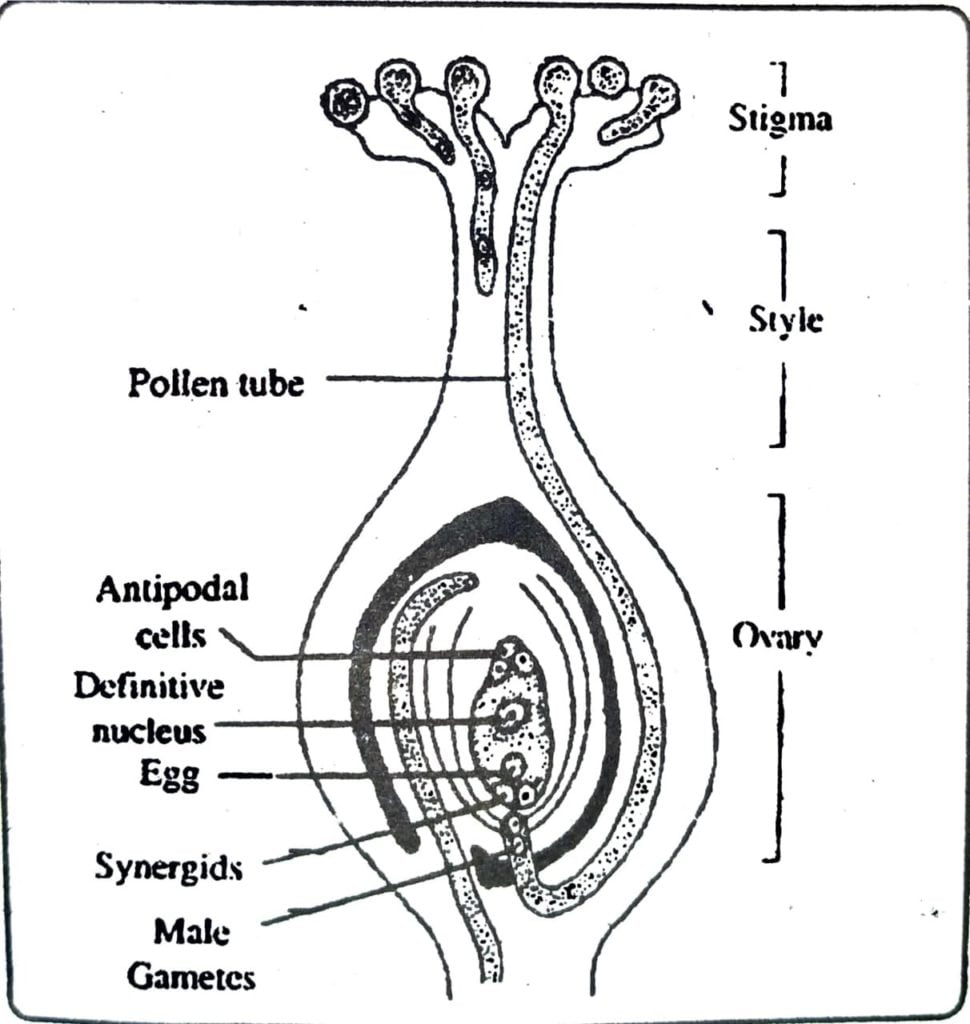Class 12 Biology Chapter 2 Sexual Reproduction in Flowering Plants The answer to each chapter is provided in the list so that you can easily browse through different chapters Assam Board HS 2nd Year Biology Chapter 2 Sexual Reproduction in Flowering Plants Question Answer.
Class 12 Biology Chapter 2 Sexual Reproduction in Flowering Plants
Also, you can read the SCERT book online in these sections Solutions by Expert Teachers as per SCERT (CBSE) Book guidelines. These solutions are part of SCERT All Subject Solutions. Here we have given Assam Board Class 12 Biology Chapter 2 Sexual Reproduction in Flowering Plants Solutions for All Subjects, You can practice these here.
II. QUESTION FOR 2 MARKS :
Q.1. Draw a diagram of LS of the angiosperm ovule and label the different nuclei present in it.
Ans :

Q.2. What do you meant by sporogenesis? Differentiate microsporogenesis from megasporogenesis?
Ans : Process of development of male and female spores in plants from mother cell of anther and ovule through reduction division is called sporogenesis. Development of pollen grains is called microsporogenesis and development of functional megaspores is called megasporogenesis. Microsporogenesis takes place in anther and megas porogenesis takes place in ovule.
Q.3. What is tripłe fusion? Where it take place? Name the nuclei involved in this event?
Ans : Fusion of one definitive nucleus (2n) and a male gamete (n) which gives rise to endosperm nucleus (3n) is called triple fusion. This takes place in embryosac.
Q.4. What is bagging technique? Mention its usefulness in the programme of plant breeding.
Ans : In hybridization the pollen grains are not allowed to fertilize the stigma of the same flower and to achieve this the anther is removed before it is matured. The stigma is then covered by a bag to prevent pollination by unwanted pollen grains. When stigma becomes matured pollen taken from desired plants are brushed upon the stigma. The bag is again put over the sigma till fertilization is over.
Q.5. Why apple is called a false fruit? Mention the parts of the flower from which this false fruit is develop.
Ans : Apple is not formed from ovary and therefore it is called false fruit. It is formed from thalamus.
Q.6. Define emasculation? When and why the plant breeder employ this technique?
Ans : See answer to question No. 4 above.
Q.7. ‘Angiosperms perform double fertilization.’ Explain the statement.
Ans : In angiosperm fertilization occurs twice. First, one male gamete fertilizes the egg cell which gives rise to embryo and second, another male gamete fertilizes the secondary nucleus to give rise to endosperm. As fertilization occurs twice it is called double fertilization.
Q.8. What is sexuality of plants? Give one example each from both monoecious and dioecious plants.
Ans : Fusion of male gamete with the egg cell of a plant is called sexuality in plant.
Example : Monoecious plant-sweet gourd
Dioecious plant – papaya.
Q.9. What are cells present in a developed embryo sac of angiosperms. Named them and mention the chromosome set found in them.
Ans : Antipodal cells, synergids, egg cell and secondary nucleus. In antipodal cells, synergids and egg cell the chromosome number is haploid (n) and in secondary nucleus the chromosome number is diploid (2n).
Q.10. What is pollination? Briefly discuss its need and significance in Angiosperms.
Ans : The transfer of pollen grains from anther to the stigma is called pollination.
Pollination is essential for fertilization to occur. Fertilization gives rise to seeds and fruit. In the absence of pollination the ovary withers away and fruit and seeds are not formed.
Q.11. Give one example from each of the following characters –
(a) Flowers having both androecium and gynoecium.
Ans : Mustard.
(b) A plant bearing both male and female flowers in the same body.
Ans : Sweet gourd.
(c) A plant where fruit is not formed from ovary.
Ans : Apple.
(d) An angiosperm in which neither fruits nor seeds are formed.
Ans : Potato.
Q.12. Which part of a seed is called the first food for the developing embryo? What is the primary sources of this food?
Ans : Endosperm. Endosperm is stored in cotyledons.
Q.13. What are functions of the cells present in a developed pollen grain which is ready to shed?
Ans : One vegetative cell and a generative cell. In some cases before the pollen grain sheds the generative cell divides to form two male gametes.
Q.14. Draw the LS of a pistil of angiosperms which is ready to take part in the process of fertilization. Label the different structure present there.
Ans :

Q.15. Distinguish between cutting and Layering. Give one example from each of them practiced in the crop plants.
Ans : When a stem is cut into a piece and put into soil for regeneration it is called cutting. The cut end develops root when a long slender stem without removing from the plant is bend down to touch soil at some point and over which a lump of soil is placed rooting takes place at the point. This mode of propagation is called layering.
Example : Cutting : Chinarose, rose, mango.
Layering : Lemon, Ixora.
Q.16. Banana is a parthenocarpic fruit where as Oranges show polyembryony. How both can be differentiate with respect to seeds?
Ans : Banana is called parthenocarpic fruit where nor seed is formed and oranges are showing polyembryony which can be defined as the occurrence of two or more embryos in one ovule. Here cells of nucellus and integuments have also been observed to develop into embryos. e.g. citrus etc.
Q.17. “Incompatibility is a natural barrier in the fusion of gametes”. Justify the statement.
Ans : Incompatibility is the inability of functional male and female gametes to effect fertilization in particular combination.
The self-incompatibility may be as follows:
(a) Heteromorphic structure: Here, some species produces more than one morphological type of flowers. Distyly and Tristyly in primula which is for incompatibility. It is found in sweet potato also.
(b) Como.morphic structure : Here incompatibility is not connected with morphological differences of flowers. The incompatibility may be due to the genotype of the plants on which it is produced (sporophytic control) or by its genotype (gametophytic control).
The sporophytic control incompatibility is reported in Radish and Brassica while the gametophytic control incompatibility is recorded in Nicotiana, Trifolium, Solanum etc. Hence we can say that incompatibility is a natural barrier in the fusion of gametes.
Q.18. What are the strategies made by some flowers to prevent self pollination?
Ans : To prevent the self pollination by the flowers the following strategies are made:
(a) They never prefer autogamy, but prefer dichogamy.
(b) They never follow the homogamy but preferring herkogamy.
(c) They never exhibit cleistogamy but produces unisexuality and flower is open.
(d) Flowers have heterostyly with self sterility.

Hi, I’m Dev Kirtonia, Founder & CEO of Dev Library. A website that provides all SCERT, NCERT 3 to 12, and BA, B.com, B.Sc, and Computer Science with Post Graduate Notes & Suggestions, Novel, eBooks, Biography, Quotes, Study Materials, and more.




I want to buy pdf